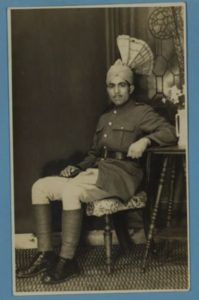by Katherine Learmont
Recently the Digital Humanities team digitised a collection of photographs, letters and other documentation relating to the Royal Indian Army Service Corps, who assisted the British army in transporting supplies and equipment during World War Two. This collection was of particular significance, as the participation of colonial soldiers in the war effort has largely been overlooked by historians and media individuals. Some have even claimed there were no Indian troops at Dunkirk. It was presented to us by Ghee Bowman, an AHRC PhD research student studying Muslim Indian soldiers during the Second World War. He had taken his own photographs but was disappointed with the image quality.
The project took around a month to complete and the collection was initially p laced in our Archive Store, which is temperature and humidity controlled according to British Library standards. Approximately 76 images were taken using a Schneider Kreuznach 240mm lens and these were converted into TIFFs and JPEGs for personal and professional use. We also used our iCAM archive system copy stand in Lab 1 to effectively flatten the documents, as well as snake weights. Ghee said that he was “overjoyed” by the resulting digitised images and felt they could enhance his research, as well as promote this fascinating area of history. Future projects within the lab include practicing photogrammetry on a set of hats from Killerton House’s costume archive, and performing immersive visualisation on a 19th century panorama of London.
laced in our Archive Store, which is temperature and humidity controlled according to British Library standards. Approximately 76 images were taken using a Schneider Kreuznach 240mm lens and these were converted into TIFFs and JPEGs for personal and professional use. We also used our iCAM archive system copy stand in Lab 1 to effectively flatten the documents, as well as snake weights. Ghee said that he was “overjoyed” by the resulting digitised images and felt they could enhance his research, as well as promote this fascinating area of history. Future projects within the lab include practicing photogrammetry on a set of hats from Killerton House’s costume archive, and performing immersive visualisation on a 19th century panorama of London.
